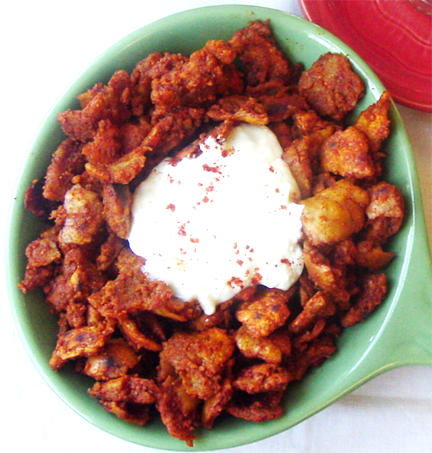| Reply to Thread New Thread |
|
|
#21 |
|
|
|
|
|
|
|
#23 |
|
|
|
|
|
|
|
#24 |
|
|
|
|
|
|
|
#25 |
|
|
|
|
|
|
|
#26 |
|
|
Injera Plate
 ---------- Post added 2012-06-06 at 18:13 ---------- Kitcha Kitcha (or kita) is a relatively thin unleavened bread typically made of wheat. It is a generally made with flour, water, and salt. It is cooked in a hot pan free-form until one side is cooked. It is then picked up and cooked on the other side. Slight burning on each side is often seen. Kitcha will take the shape of the pan it is cooked in (much like a pancake, though it bears no relation). It is most frequently eaten in a dish called fit-fit.  Kitcha fit-fit 
|
|
|
|
|
#28 |
|
|
Is it fried chicken pieces = Kitcha fit-fit ? _ Injera fit-fit Injera fit-fit (var. enjera fetfet; also taita fit-fit in Tigrinya) is a combination of shredded injera, berbere, onions and clarified butter. Variations on this basic recipe are common in which the name of the additional item is commonly used as a prefix. For instance, if one were to add shiro (chickpeas puree), the resulting dish would be called shiro fit-fit. If one were to add broth (mereq) it would be called mereq fit-fit. In Eritrea, leftover meat-sauces (zighni or tsebhi) are often added to injera fit-fit and served with raw chili-peppers and yoghurt on the side, for breakfast. Injera fit-fit can be eaten with either a spoon (which is not typical in Ethiopian cuisine) or another piece of injera. Kitcha fit-fit Kitcha fit-fit (variations in Ethiopia: kita fir-fit, kita fir-fir; also known as chechebsa) is a combination of shredded kitcha (Tigrinya) (or kita in Amharic), berbere, and clarified butter.Kitcha fit-fit is sometimes eaten with plain yogurt (urgo in Amharic and rug-o in Tigrinya). Unlike most Ethiopian foods, kitcha fit-fit is eaten with a utensil (usually a spoon). A dry variation is called kitcha in Tigrinya (or kita in Amharic). ---------- Post added 2012-06-06 at 18:32 ---------- Berbere (Amharic: á*á*á*ᬠberberÄ, Tigrinya: á*á*á*ᨠberbere) is a spice mixture whose constituent elements usually include chili peppers, garlic, ginger, dried basil, korarima, rue, white and black pepper and fenugreek. It serves as a key ingredient in the cuisines of Ethiopia and Eritrea. Berbere sometimes encompasses herbs and spices that are less well known internationally. The latter include both cultivated plants and those that grow wild in Ethiopia, such as korarima (Aframomum corrorima) and long pepper.  ---------- Post added 2012-06-06 at 18:34 ---------- Mitmita (Amharic: áá¥áá£?, IPA: [mitʼmitʼa]) is a spicy powdered seasoning used in the cuisine of Ethiopia. It is orange-red in color and contains ground African birdseye chili peppers, cardamom seed, cloves and salt. It occasionally has other spices including, but not limited to, cinnamon, cumin and ginger. The mixture is used to season the tartar "kitfo", and may also be sprinkled on ful (fava beans). In addition, mitmita may be presented as a condiment and sprinkled on other foods or spooned onto a piece of injera, so food can be lightly dipped into it. ---------- Post added 2012-06-06 at 18:41 ---------- Niter kibbeh, or niter qibe (Ge'ez áá¥á* á ᤠniá¹*er ḳibÄ), also called tesmi (in Tigrinya), is a seasoned, clarified butter used in Ethiopian cooking. Its preparation is similar to that of ghee, but niter kebbeh is simmered with spices such as cumin, coriander, turmeric, cardamom, cinnamon, or nutmeg before straining. This imparts a distinct spicy aroma to it. In Somaliland, it is known as subag Soomaali and is extensively produced and used in cooking in households and to preserve meats in nomadic culture. The ingredients are a bit different, as Somalis use fresh butter, garlic, cardamom and cloves. 
|
|
|
|
|
#31 |
|
|
Not exclusively, it's widely eaten in Ethiopian as well.  ---------- Post added 2012-06-07 at 12:56 ---------- Himbasha (Ge'ez: ááá£á»; var. Ambasha, á*áá£á») is an Ethiopian and Eritrean celebration bread that is slightly sweet. It is often served at special occasions. It is prepared in a number of varieties, however the most distinctive flavoring is ground cardamom seeds. The dough is given a decorative touch before baking. The design varies in detail, but in general is given the shape of a wheel with indentations to create several spokes (see picture). Common additions to the recipe include (candied) ginger or raisins, although plain varieties are common also.  
|
|
|
|
|
#32 |
|
|
|
|
|
|
|
#34 |
|
|
|
|
|
|
|
#36 |
|
|
|
|
|
|
|
#37 |
|
|
|
|
|
|
|
#40 |
|
|
|
|
|
| Reply to Thread New Thread |
«
Previous Thread
|
Next Thread
»
| Currently Active Users Viewing This Thread: 22 (0 members and 22 guests) | |
|
|










 Linear Mode
Linear Mode


